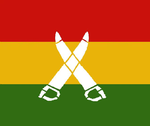Ghadar Party | |
|---|---|
 | |
| President | Sohan Singh Bhakna |
| Founded | 15 July 1913 |
| Dissolved | January 1948 |
| Ideology | Indian independence Indian nationalism |
| Colours | Red, saffron, green |
The Ghadar Movement or Ghadar Party was an early 20th-century, international political movement founded by expatriate Indians to overthrow British rule in India.[1]
Following the outbreak of World War I in 1914, some Ghadar Party members returned to the Punjab to incite armed revolution for Indian independence. Ghadarites smuggled arms into India and incited Indian troops to mutiny against the British. This uprising, known as the Ghadar Mutiny, was unsuccessful, and 42 mutineers were executed following the Lahore Conspiracy Case trial. From 1914 to 1917, Ghadarites continued underground anti-colonial actions with the support of Germany and Ottoman Turkey, known as the Hindu–German Conspiracy, which led to a sensational trial in San Francisco in 1917.
Following the war's conclusion, the party in the United States fractured into a communist and an Indian socialist faction. The party was formally dissolved in 1948.[1] Key participants in the Ghadar Movement included K. B. Menon, Sohan Singh Bhakna, Mewa Singh Lopoke, Kesar Singh, Baba Jawala Singh, Balwant Singh, Santokh Singh, Bhai Parmanand, Vishnu Ganesh Pingle, Bhagwan Singh Gyanee, Har Dayal, Tarak Nath Das, Bhagat Singh Thind, Kartar Singh Sarabha, Udham Singh, Abdul Hafiz Mohamed Barakatullah, Rai Nawab Khan, Rashbehari Bose, and Gulab Kaur. Although its attempts at overthrowing the British Raj were unsuccessful, the insurrectionary ideals of the Ghadar Party influenced members of the Indian independence movement opposed to Gandhian nonviolence.
- ^ a b "Ghadr (Sikh political organization)". Encyclopædia Britannica. Archived from the original on 10 November 2010. Retrieved 18 September 2010.